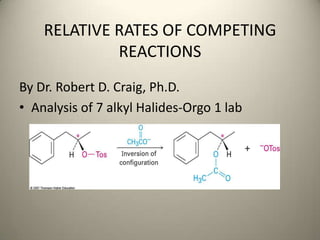
7 alkyl halides new
- 1. RELATIVE RATES OF COMPETING REACTIONS By Dr. Robert D. Craig, Ph.D. • Analysis of 7 alkyl Halides-Orgo 1 lab
- 2. your analysis • In your analysis of these experiments consider the : • Nature of the leaving group • Effect of the structure of the alkyl halide • Effect of the solvent • Effect of the temperature
- 3. The procedure for today!! • In the experiments that follow, 7 alkyl halides are treated with sodium iodide in acetone and with ethanolic solution of silver nitrate. • • 1. Sodium Iodide in Acetone • 2. ethanolic silver nitrate solution
- 4. 7 alkyl halides • The seven alkyl halides are 1-chlorobutane, 1- butane, 2-chlorobutane, 2-chlorobutane, 2- chloro-2-mehtylpropane, 2-brombutane, 1- chloro-2-methylpropane and bromo benzene. • • • You can just follow pg 338 to 340 exactly! Th Microscale Run. Low level Stress!!! •
- 5. 1. Sodium Iodide in Acetone favors the Sn2 reaction • Acetone with a dielectric constant of 21 is a relatively nonpolar solvent that will readily dissolve sodium iodide. The iodide ion is an excellent nucleophile, and the nonpolar solvent (acetone) favors the Sn2 reaction; it does not favor ionization of the alkyl halide.
- 6. Sodium Iodide in Acetone favors the Sn2 reaction nucleophile Electrophile Rate = k[ROTs][OAc] Leaving Group
- 7. favors the Sn2 reaction • The extent of reaction can be observed because sodium bromide and sodium chloride are not soluble is acetone and precipitate from solution if a reaction occurs.
- 8. A precipitation reaction!! Na+ I- + R-Cl R-I + NaCl (s) Na+I- + R-Br R-I + NaBr (s)
- 9. 2. ethanolic silver nitrate solution Favors an Sn1 • When an alkyl halide is treated with an ethanolic solution of silver nitrate, the silver ion coordinates with an electron pair of the halogen. This weakens the carbon-halogen bond because a molecule of insoluble silver halide is formed, the promoting an Sn1 reaction of the alkyl halide. The solvent, ethanol, favors ionization of the halide, and nitrate ion is a very poor nucleophile, so alkyl nitrates do not form by an Sn2 reaction.
- 10. Rate-determining step is formation of carbocation rate = k[RX]
- 11. SN1 in Reality
- 12. Carbocation is wants to do it own thing! • Carbocation is more likely to react on side opposite leaving group • Suggests reaction occurs with carbocation loosely associated with leaving group during nucleophilic addition (Ion Pair)
- 13. lets make it happen! R-X Ag+-> R-X -> R+ + AgX (s) • On the basis of the foregoing discussion, • Let’s “make it happen!” • • The Microscale run!
- 14. The Microscale run • Label 7 small containers (reaction tubes, 3 mL, centrifuge tubes, 10 x 75 mm test tubes, or 1 mL vials), and place 0.1 mL of 100 mg of each of the following halides in the tubes. •
- 15. The Microscale run • Youre alkyl halides! • 1-chlorobutane, 1-butane, 2-chlorobutane, 2- chlorobutane, 2-chloro-2-mehtylpropane, 2- brombutane, 1-chloro-2-methylpropane and bromo benzene
- 16. The Magic ! • To each tube then rapidly add 1 ml of 18% solution of sodium iodide in acetone, stopper each tube, mix the contents thoroughly, and note the time.
- 17. The precipitate!!! • Note the time of the first appearance of any precipitate. If no reaction occurs within about 5 min, place those tube in a 50 oC water bath and watch for any reaction over the next 5 to 6 min.
- 18. The precipitate!!! • Empty the tubes, rinse them with ethanol, place the same amount of each of the alkyl halides in each tube as in the first part of the experiment, add 1 ml of 1% ethanolic silver nitrate to each tube, • And note the time of addition of as well as the time of appearance of the first traces of any precipitate. •
- 19. unreactive halides • If a precipitate does not occur in 5 min, heat the tubes containing these unreactive halides in a 50 oC water bath for 5 to 6 min and watch for any reaction
- 20. effect of the solvent • To test the effect of the solvent on the rate of Sn1 reactivity. Compare the time needed for a precipitate to appear when 2-chlorobutane is treated with 1% ethanolic silver nitrate solution and when treated with 1% silver nitrate in a mixture of 50% ethanol and 50% water .
- 21. Tertiary alkyl halides react rapidly in protic solvents in Sn1
- 22. Lets go to the Video tape!!! • http://www.youtube.com/watch?v=g5_GEzr9 1BQ • • http://www.youtube.com/watch?v=hXIQUChlJ q0&feature=related
